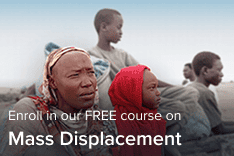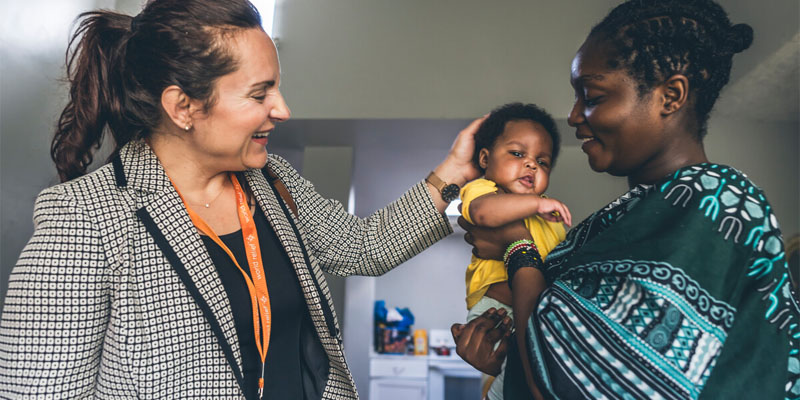For years governments and humanitarian organizations have poured money and effort into global aid. With the state of our world today, it’s no wonder people ask, “What has this accomplished? Is there a better way?”
Over seven decades, World Relief has operated in more than 110 countries alongside governments and other humanitarian organizations. Over these years, the successes and failures of our efforts have become clearer.
Humanitarian organizations bring essential emergency aid to those caught up in natural and man-made disasters. They make meaningful contributions to lifting people out of material poverty, reducing preventable diseases and increasing access to education.
However, too much of the public’s focus and money is consumed by crisis interventions and progress is rarely sustained after the initial response. And too often, interventions address only symptoms of vulnerability rather than root causes. They stop at the front door of the home and don’t address what goes on at a familial and relational level. Too often they lead to cultures of dependency, incredible waste, and even fraud and corruption. For all the progress, 1.3 billion people are still living in extreme poverty and—according to a recent World Bank report—these people are becoming far harder to reach.
World Relief believes there is an answer to these challenges. And it lies in engaging the local church and leveraging it to do what neither governments nor social enterprises nor multinational corporations are able to do.
The story of Dr. John Snow, the father of modern public health, is a most illuminative example. During the 1854 cholera outbreak in London, Snow became convinced that the disease was spreading through water contaminated by human waste, but he needed the help of local clergyman Reverend Whitehead to engage with the local community to map the households where cholera had occurred. This legendary collaboration reflected a shared commitment to the health and well-being of all people and an appreciation of the value of trusted relationships and community support in affecting change. It became the basis for modern-day epidemiology and pointed the way to the collaboration we so often need today.
Today—even with scientific and technological progress—the church still has a crucial role to play as it follows Jesus’s command to love “the least of these.”
Most people will remember the 2014 Ebola crisis in West Africa and the ripple of fear that went around the world. We all applauded the courage of medical workers who bravely served on the front lines and the work of scientists and doctors to develop a vaccine in record time. But less well known, perhaps, was the critical role that faith leaders played to complement and extend the impact of government and humanitarian aid organizations, convincingly documented in a 2015 Report, “Keeping the Faith” by Christian Aid, CAFOD, Tearfund and Islamic Relief Worldwide.[1]
In Liberia and Sierra Leone, the majority of the population are practicing believers, and faith leaders enjoy significant trust and respect. Unfortunately, there was a significant delay in engaging these leaders at the start of this most severe Ebola outbreak in history. As the disease spread, draconian measures were taken which went against cultural values and religious practices, resulting in a widespread public denial of the disease and even hostility towards those who were seeking to contain it. Many of those with Ebola chose to remain with their families and burials were undertaken in secret. As a consequence, the disease continued to spread. Government messaging on the cruel medical realities of Ebola spoke to people’s intellect, but did not create behavior change; rather, such messaging served to push care of the sick, as well as traditional approaches to burials, underground.
Later, once faith leaders became involved, they played a transformational role. Using religious texts, they preached acceptance of Ebola workers and survivors and role modeled this acceptance in religious services. They also helped to drive out the stigma that was destroying community cohesion. Where Ebola-control practices were considered irreligious, it was the participation of religious leaders alone that enabled an acceptance of the necessary changes to curb the spread of the disease.
The HIV/AIDS crisis provides another and perhaps even more compelling example of how critical it is to work with a deep respect for, and understanding of, traditional belief systems in order to impact sustained change. Twenty years ago, most people in Africa believed that AIDS was a plague from God and that it targeted sinners, who were merely “reaping what they had sown.” But then church leaders mobilized, and through the efforts of PEPFAR’s Track 1.0 AIDS Relief Program, they led their communities in reducing the demonization and stigma associated with the disease, encouraging care and treatment of HIV through voluntary testing, counseling and wide antiretroviral [ARV] distribution. Today 10 million people in Africa are on ARVs—a remarkable number when one considers that a mere 12 years ago there were almost no patients enrolled in official ARV programs. (For more details on the role of faith based organizations in combatting HIV/AIDS, see The PEPFAR Report, A Firm Foundation.[2])
Three attributes of church leaders make their influence in these situations particularly effective. First, they are highly motivated to support their communities and do so out of a spirit of compassion. Second, they usually have unparalleled access to, and knowledge of, their communities, especially in hard-to-reach areas where many of the world’s most vulnerable are concentrated. Third, they are trusted by these communities because of their moral voice and long-term presence and commitment. Unlike traditional NGOs, churches have no exit plan.
At World Relief, we truly believe the local church is God’s primary answer to the broken world, and his preferred plan to bring redemption—whether physical, spiritual or social—to his people.
Ephesians 3 states that “His purpose was that now, through the church, the manifold wisdom of God should be made known to the rulers and authorities in the heavenly realms.”
Through the church’s responses, we see God revealing his wisdom and redemption, pushing the darkness back. We are the hands and feet, but the power and the glory are his.
The same strengths that have made the church such a powerful force for good in the examples above do not stop there. Our experience convinces us that these same strengths, when properly harnessed, create a unique platform for the alleviation of poverty, for long-term community development, for the welfare of women and children, for peace and reconciliation, and for developing resilience to recurring disasters like drought and hurricanes.
Our experience convincingly demonstrates that long-term sustainable solutions are more likely to be truly transformative when we recognize the importance of local ownership and the unique position and moral authority of the local church; when we recognize that poverty is not just economic but that it takes many forms; when we recognize the crushing weight of despair and the power that comes with hope and the restoration of dignity; and when the church acts in unity to serve its community.
This is why the local church is at the heart of our theory and praxis of change. Not only because it is our calling, but because we have seen and been touched by the concrete evidence of its transformative power—physically, socially and spiritually—in our work around the world.
In Sub-Saharan Africa, where we are operating our innovative Church Empowerment Zone models, the impact of our work has multiplied throughout villages and even entire communities. We rely on the local church to carry messages concerning health, agriculture, savings, family strengthening, and child development to their neighbors. Our unique model empowers churches and their leaders to realize and fulfill their God-given potential to serve the most vulnerable in their communities, working collaboratively across tribal and denominational lines, and joining in unity with a common vision for their communities.
By building the capacities of church leaders and their congregations, and by enabling them to identify the unique needs and harmful beliefs in their communities, we ensure sustainable transformation comes from within and can multiply and expand once World Relief exits. In this way we are helping to move whole communities from despair to hope, from dependence to self-reliance, from broken relationships to thriving families, and from isolation and loneliness to shalom. We are also ensuring that the local church is not just a convenient delivery mechanism for our services, but the essential foundation of our work—pivotal in how we create real and lasting transformation that integrates physical, spiritual and social development, both individually and at the community level.
Of course, none of this undermines the importance of government and humanitarian NGOs. In fact, public/private partnerships have never been more important given the multitude and scale of the challenges we face in the world today. And we need to stay open to collaboration with new social enterprises which bring much needed innovation to longstanding and previously intractable challenges.
Just as Dr. Snow and Reverend Whitehead discovered over 150 years ago, each of us have a role to play in seeking the well-being of all people, and we are stronger and better when we work together.
Over the coming months, we will be sharing a series of posts, entitled Perspectives, that demonstrate the extraordinary effectiveness of our Church Empowerment Zone model and how the principles that make it so powerful can also be applied to issues such as economic development, peace and reconciliation, disaster resilience, and maternal and child health, to name a few. These pieces will reveal that there are few other models capable of the kind of impact and leverage that we see when we harness the power and potential of the local church.
[1] Keeping the Faith (reliefweb.int)
[2] A Firm Foundation (pepfar.org)

Tim Breene served on the World Relief Board from 2010 to 2015 before assuming the role of CEO in 2016. Tim’s business career has spanned nearly 40 years with organizations like McKinsey, and Accenture where he was the Corporate Development Officer and Founder and Chief Executive of Accenture Interactive. Tim is the co-author of Jumping the S-Curve, published by Harvard Publishing. Tim and his wife Michele, a longtime supporter of World Relief, have a wealth of experience working with Christian leaders in the United States and around the world.


